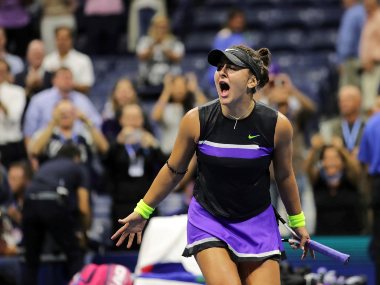How did Bianca Andreescu take down Serena Williams in the US Open final? Those who watched the match would readily attest that she did it primarily through her return of serve. Whenever Serena missed a first serve (and she missed a lot of them), Andreescu was all over the ball. Regularly sending it back with pace and depth, she handcuffed the American in a way that few other players in history have been able to, completely neutralising her most lethal weapon. [caption id=“attachment_7296311” align=“alignleft” width=“380”] Bianca Andreescu’s all-court, all-purpose game is in tune with growing diversity on the women’s circuit. AP[/caption] But did Andreescu rely on the same tactic — returning and reacting with interest — to triumph over all her opponents in New York? The short answer is no. Against Belinda Bencic in the semi-final, she was ruthlessly proactive, taking control with her serve rather than her return. Against Elise Mertens, in the quarterfinal, her calling card was the width and height she could generate with her groundstrokes. And against Taylor Townsend in the fourth round, she played like a claycourter by hitting inch-perfect passing shots from the dead run. Much has already written about Andreescu’s remarkably large repertoire of shots and tactics, which undoubtedly make her a very special player. But the emergence of a player like Andreescu is not an accident. The Canadian is, in fact, a combination of the various styles and strengths that have been developing on the women’s tour lately. She represents the crest of a wave that started a couple of years ago, at a time when women’s tennis was in serious danger of being pushed into the shadows. At the beginning of this decade, there was only one style of play — baseline ball-bashing — that was guaranteed to earn success on the women’s tour. The template that had been set in the 2000s by the Williams sisters, Maria Sharapova, Lindsay Davenport, Jennifer Capriati, and Kim Clijsters peaked by the mid-2010s, and it didn’t necessarily make for pleasant viewing. Most of the Slam champions from 2011 to 2015 had the same basic style of play: See the ball, hit the ball (and grunt while hitting the ball). By contrast, the start of the 2010s on the men’s tour marked the end of a long period of dominance by Roger Federer, who had been carrying the mantle of ‘variety’ all by himself. With Federer at the top, the tour could never be accused of being one-dimensional or cookie cutter, and the connoisseurs couldn’t stop raving about the ‘good health’ of the sport. Even as Federer declined, his place was taken up by Rafael Nadal and Novak Djokovic, who were polar opposites of the Swiss in their style of play. There was never any shortage of variety through the peak of the Big 3 era, as each of them brought a special uniqueness to the table that enthralled spectators all over the world. The difference couldn’t have been starker: The men’s tour was filled with excellence in a wide range of departments, while the women’s tour screeched along on the back of one-note power. It’s no coincidence that the arguments against equal pay for men and women were also at their loudest during that period. Then in 2016, Angelique Kerber defeated Serena Williams in the Australian Open final, and a whiff of change appeared. For the first time in ages, defence won over offence; for the first time in ages, a style other than relentless ball-bashing looked viable. It can’t be denied that Kerber’s win coincided with the first signs of decline for Serena (who also lost the subsequent Slam final, at Roland Garros, to Garbine Muguruza). But it was still something that could be built upon, and the likes of Sloane Stephens, Caroline Wozniacki, and Simona Halep didn’t need to be asked twice. Kerber herself added two more Majors to her collection using her Nadal-style lefty defence, while the others used their own brand of athletic counterpunching to create a new dominant style on the tour. Then at the end of 2018, Naomi Osaka and Elina Svitolina combined the two styles to win the last two big titles of the year, and the gates were thrown wide open. Sure, coaches around the world still insist on putting their charges through practice drills focused on hitting as hard and deep from the baseline as possible. But with the success of Kerber and Halep, the importance of squash shots, slices and drop shots has resurfaced. And with players at all levels so accustomed to the power baseline style (and almost nothing else), even slight disruptions in rhythm through variety and finesse can reap rich rewards. The year 2019 has hit peak variety at the Slams; it has seen a bit of everything. No longer shackled by the idea that you have to crush the ball from the baseline to win big, players with wildly different games have risen to the top and taken their rightful place in the hall of champions. Osaka won the year’s first Slam with her controlled baseline aggression (as opposed to the all-out power of the previous year’s ball-bashing champions Muguruza and Jelena Ostapenko). At Roland Garros, Ashleigh Barty turned back the clock and defeated all comers with her old-school slice-and-dice game. At Wimbledon, Halep kept the counterpunchers’ flag flying high. And at the US Open, Andreescu borrowed a little from everyone’s style to create a glorious amalgamation of tricks. In a strange turn of events, this varied, all-encompassing group of elite female players is now accompanied by a depressingly homogeneous style on the men’s side. The Big 3 has been whittled down to the Big 2 at the Slams, which means there’s only one dominant trait among the men: Consistent and occasionally aggressive counterpunching. Nadal and Djokovic are ruling the roost at the Majors with their astoundingly agile baseline play, and the Spaniard’s win over a similarly consistent Daniil Medvedev in the US Open final was just the latest example of that. Some might argue that this is just a temporary phenomenon or a coincidence, but one look at the upcoming youngsters on both tours is enough to dispel that notion. The 23-or-younger brigade among the women consists of the touch artist Marketa Vondrousova, the smooth-hitting Amanda Anisimova, the spin wizard Daria Kasatkina, the intelligently-athletic Coco Gauff, and the aforementioned Osaka and Andreescu. On the other hand, the promising men’s youngsters like Felix Auger-Aliassime, Borna Coric, Alexander Zverev and the new Slam finalist Medvedev all borrow from the Djokovic playbook of deep and heavy-hitting from the baseline. There are many different formulae for success on the women’s tour, but just one on the men’s. If the last 10 years in tennis have taught us anything, it is that no trend lasts forever. Men’s tennis was more compelling and varied than women’s in the mid-2010s, but the opposite is true right now. Playing styles and patterns are constantly evolving; the apparent superiority of one tour over another can easily be reversed by the throwaway success of just one player at one Slam. Andreescu’s win at this year’s US Open was thrilling and refreshing at the same time, and it has been that way for a while on the women’s tour. We can rest assured that there won’t be many voices against equal pay in the near future.
Andreescu’s win at this year’s US Open was thrilling and refreshing at the same time, and it has been that way for a while on the women’s tour. We can rest assured that there won’t be many voices against equal pay in the near future.
Advertisement
End of Article


)

)
)
)
)
)
)
)
)



